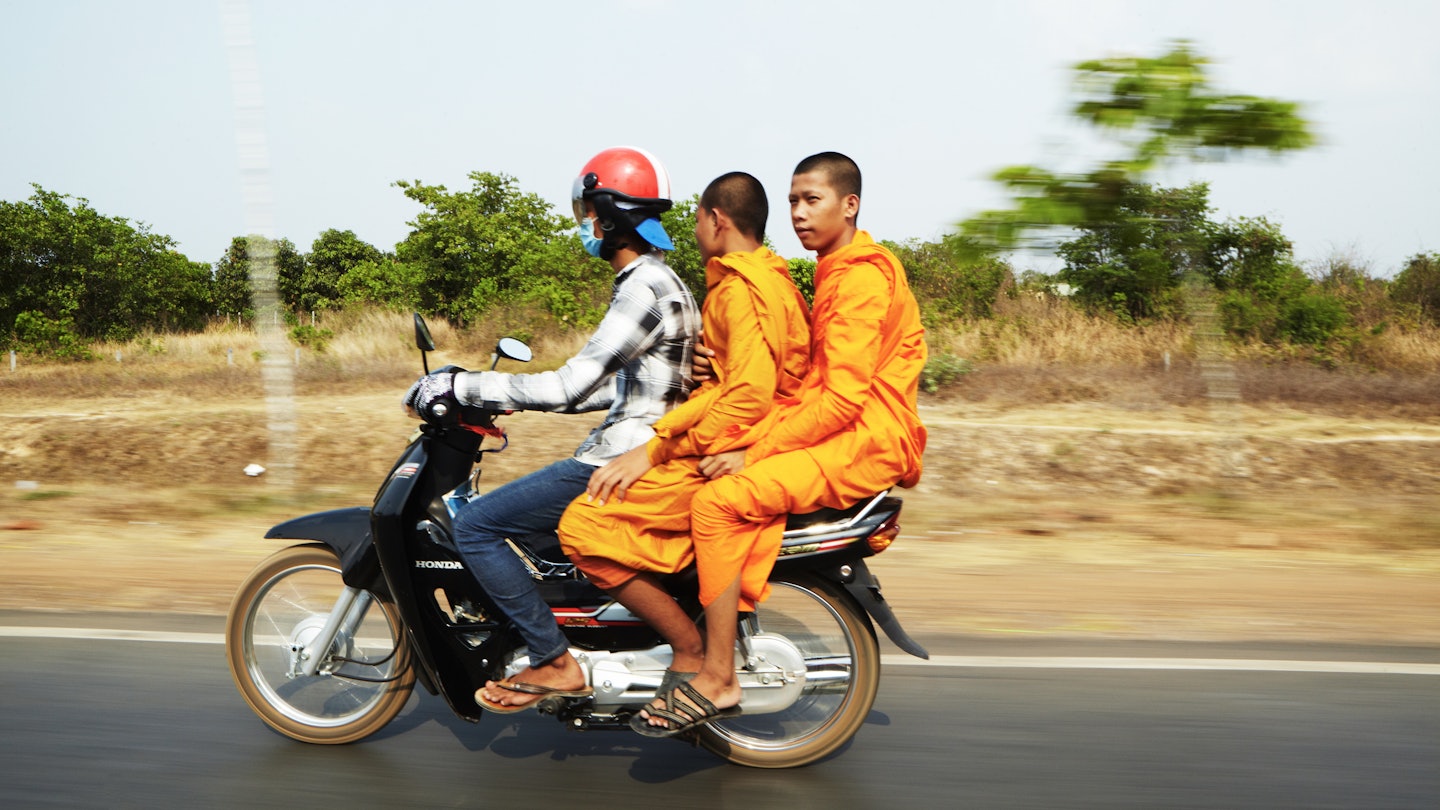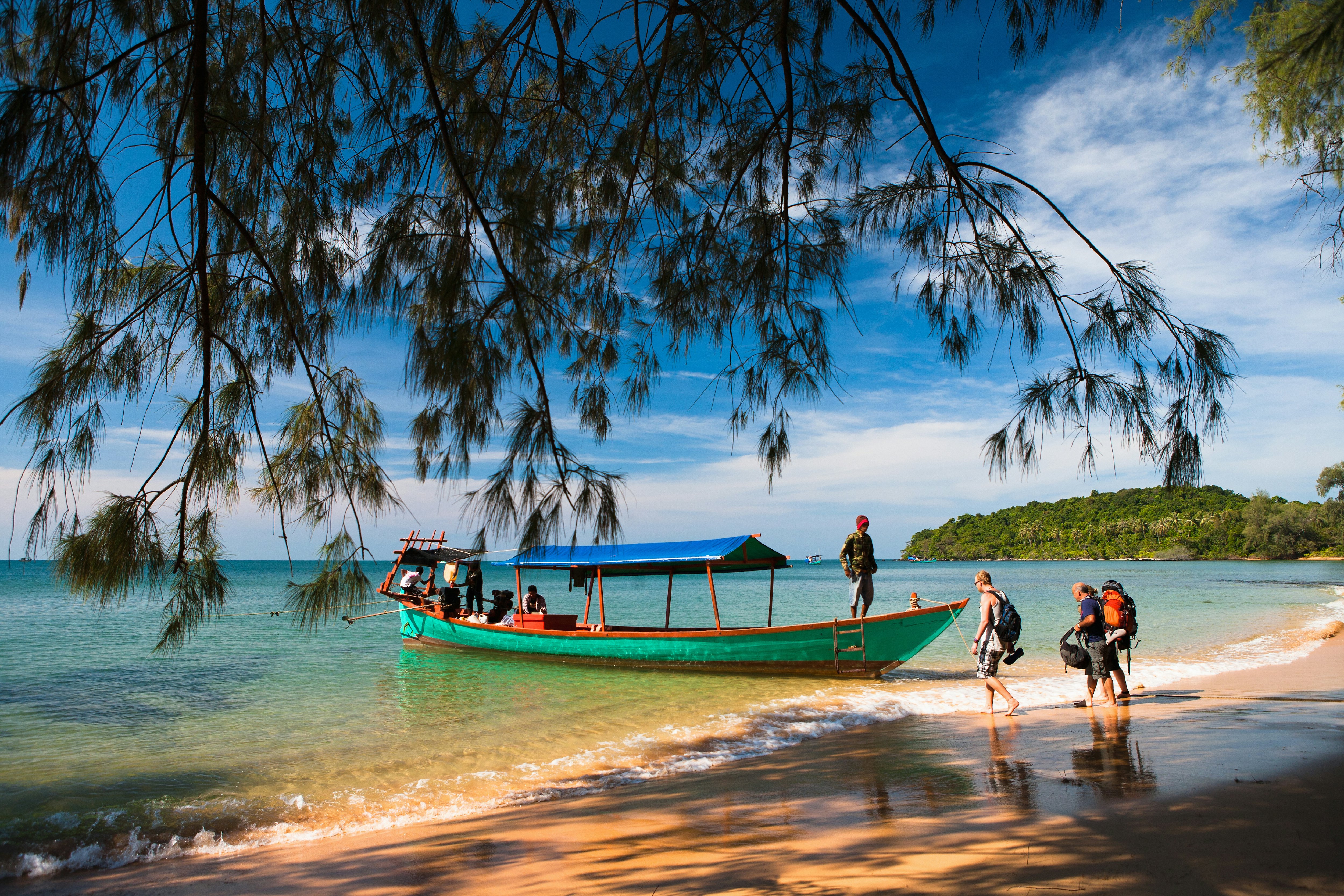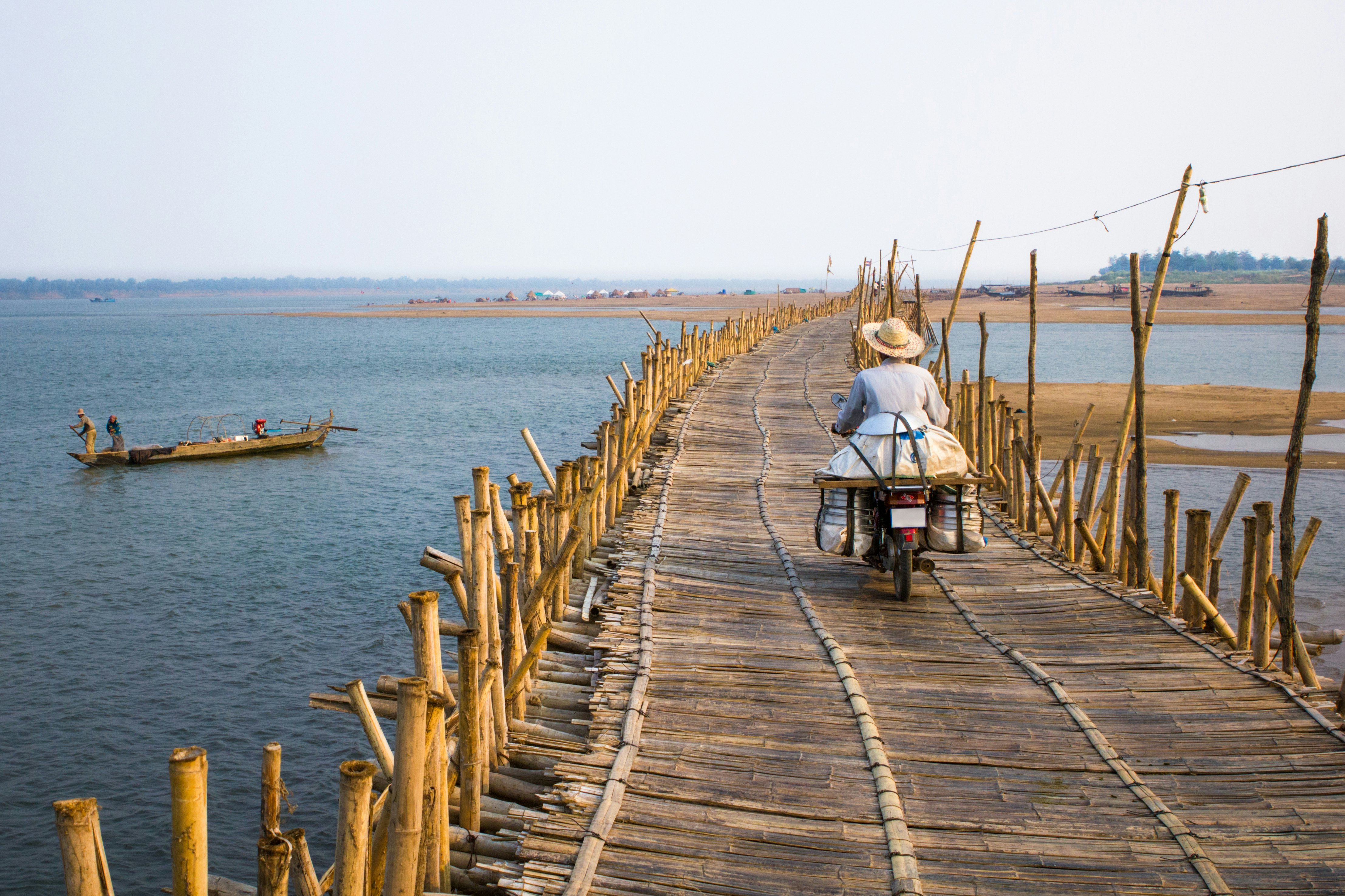

Motorcycle taxis cover short routes in Cambodia. Mark Read for Lonely Planet
Nick Ray is the author of the Phnom Penh and Siem Reap chapters of Lonely Planet's Cambodia guidebook, which was published in September 2025.
It’s not hard to navigate between the famed temples, jungles and beaches of Cambodia.
Still, even though the country’s roads have improved massively in recent years, conditions can vary widely from the dry to the wet season. And any traveler should count on trips between points of interest being cheaper than they are quick.
Buses and minivans are the most popular forms of transport for travelers, with routes connecting all major towns, cities and tourist hubs. Renting a private car or 4WD with a driver is an affordable option for those who value time over money, while renting a motorcycle is a highly rewarding way for experienced riders to take in the magnificent countryside.
Domestic flights link Phnom Penh, Siem Reap and Sihanoukville – though cruising at altitude denies you the adventure of traveling by road. Boat travel is less common than it used to be, yet many fast speedboat services ply the islands off the South Coast, and ferries cruise Tonlé Sap Lake and the Mekong and Sangkae Rivers. Train services link Phnom Penh to the coast and the border with Thailand at Poipet in the northwest, even if departures are infrequent.
However you prefer to travel, here are our top ways to get around Cambodia.

Air travel saves time and avoids uncomfortable journeys
While you should always give thought to the carbon cost, shuttle flights avoid Cambodia’s unpredictable roads and are frequent between the country’s three functioning airports (in Phnom Penh, Siem Reap and Sihanoukville). And they provide generally good value, unless you book at the very last minute.
Airlines tend to come and go in Cambodia, with many of the newer carriers oriented to serve the booming Chinese market. Reliable options include Cambodia Airways, Air Cambodia and Sky Angkor Airlines, all of which offer a mix of domestic routes and links to other hubs in Asia.
Buses and minivans form the backbone of local transport in Cambodia
Large and comfortable air-conditioned buses and speedy express minivans are travelers' most popular choices for traveling on paved roads in Cambodia. All of Cambodia's major cities are well connected to Phnom Penh by modern express buses that follow paved highways, though if you’re traveling from one end of the country to the other, you may have to change buses in Phnom Penh or another hub, which can add to the overall journey time. While it doesn’t cover all of Cambodia’s bus companies, the BookMeBus platform provides a great option for booking bus tickets across the country.
Unlike crowded local buses, express minivans operate on a one-seat, one-passenger basis and are reasonably comfortable. Some drivers do seem to think that they are taking part in a Formula 1 qualifier, so wear a seatbelt if you have the choice. Older minibuses serve provincial routes but are not widely used by tourists, as they are painfully slow and often uncomfortably overcrowded.
Shared taxis supplement some regional routes
In these days of ever-improving roads, shared taxis – with each passenger paying for a seat and the vehicle leaving when it’s full – are losing ground to express minivans. Yet this tried-and-true intercity method persists. When using shared taxis, you’ll have an advantage if you can buy up spare seats to make the journey more comfortable. You won’t necessarily encounter fixed prices on every route, so come prepared to negotiate a fare before you set off.

Get around Cambodian cities by cyclo, tuk-tuk or moto
As in Vietnam and Laos, the cyclo (bicycle rickshaw or pedicab) provides a cheap way to get around urban areas – though these days, these vehicles are an endangered species. If you can find one, fares range from 1–3 US dollars (US$). (Cambodia’s official currency is the riel, but the US dollar is widely accepted.) Passengers sit up front, with the driver behind: a sort of a giant pedal-powered push chair.
You’ll find two main types of tuk-tuks (motorized auto-rickshaws) in Cambodia, and both can be booked using ride-hailing apps such as Grab and PassApp. The agreeably old-fashioned remork-moto is a canopied trailer hitched to the back of a motorcycle, allowing two people to travel in comfort. These are a great way to explore temples, as you get a refreshing breeze and some protection from the elements. In recent years, a sizable fleet of Indian-made auto-rickshaws has descended upon Cambodia’s urban landscape. They are faster than their simpler cousins, but generally much smaller and with less airflow, as there’s a wraparound cab.
Also known as motodups (meaning moto driver), motos are motorcycle taxis that cover short routes in towns and local hops in the countryside. They are a useful way to quickly travel around towns and cities – even if rides in traffic can be scary. Prices run about US$1–2, depending on the distance traveled. It’s best to negotiate a fare upfront to avoid unexpected overcharging, especially at night.
Cycling is a rewarding adventure
Cyclists will appreciate exploring Cambodia, though any pedaler should be cautious about cycling off-road due to the presence of land mines. We recommend a sturdy mountain bike, thanks to the unpredictable state of the roads. Most roads in the countryside have an unpaved but flat walking trail along the side, which is also useful for (and used by) cyclists. Bicycles can be transported around the country on the roof of minibuses, sparing you long rides on major roads.

Renting a car or motorcycle offers maximum freedom
Renting a car or motorcycle is relatively cheap and gives you the flexibility to visit out-of-the-way places and to stop where and when you choose. While it’s more expensive than traveling by bus or minivan, the value increases if you can share the cost with a group.
Cars can generally only be hired with a driver in Cambodia, which can be a useful way to explore both Phnom Penh and Angkor, as well as travel between cities at convenient times. Some tourists with big budgets also arrange cars or 4WDs with drivers for touring the provinces. Hiring a car with a driver will cost US$40–50 for a day in or around major towns, rising to US$60 or more – plus fuel – for rural areas.
It’s also possible to rent a motorcycle, though anyone planning a longer ride should try out the bike around town for a day or so to get used to the traffic conditions and make sure the bike is in good working order. Motorcycles are available for rent in Phnom Penh and most other tourist towns: a 100cc motorcycle will cost US$4–6 per day (double that on the islands), while a 250cc dirt bike will cost US$15–25.
I have to sing the praises of exploring Cambodia by motorcycle: the freedom to stop when and where you want is unrivaled. Novice riders should stick to short rides around smaller towns such as Siem Reap and Kampot, rather than diving into the tangled traffic of Phnom Penh. Experienced riders can hit the road on a dirt bike and take on the gnarly roads of the Cardamom Mountains for a truly epic adventure.

Boat rides are the way to reach the Southern Islands
Given the major improvements to the road network, Cambodia’s 1900km of navigable waterways are not as crucial as they once were for travelers. The Mekong and Tonlé Sap Rivers are navigable year-round, meaning boats provide an enticing trip from the capital to Siem Reap (outside of the dry season, when water levels are low in Tonlé Sap Lake). There are also scenic boat services between Siem Reap and Battambang. Still, most inland transport these days is by road.
Visitors are most likely to take to the water on the speedboats that zip from Sihanoukville and other coastal towns to the Southern Islands, including the high-speed catamarans that run to Koh Rong and Koh Rong Sanloem. Sunset boat cruises on the Mekong River in Phnom Penh are an essential experience when passing through the capital.
Trains trundle to the Thai border and the coast
Cambodia’s rail system has been rehabilitated in recent years, with limited passenger services operated by Royal Railway. The southern line links Phnom Penh with Sihanoukville via Kampot and Takeo, and the northern line runs from Phnom Penh to Poipet on the Thai border, via Pursat and Battambang.

What kind of license do you need to drive in Cambodia?
You need a Cambodian driving license to drive a car, so self-driving rentals are rare. When it comes to renting motorcycles, no license is required for motorcycles under 125cc. Fuel is readily available throughout the country – even the most isolated communities usually have stands by the road selling gasoline out of reused Johnnie Walker or Fanta bottles – but it's relatively expensive, at US$1–1.50 per liter.
Accessible travel in Cambodia
Congested sidewalks, potholed roads and steep, uneven steps at temples and historic sites make Cambodia a tricky country to get around for people with mobility issues. Few buildings have been designed with accessibility in mind, although flagship projects such as the international airports at Phnom Penh and Siem Reap have wheelchair-accessible ramps and toilets, as do most top-end hotels.
Buses and minivans are often very overcrowded; renting a taxi for the day or for point-to-point transfers is affordable. On the plus side, Cambodians are very helpful toward visitors, and hiring local assistance is cheap if you need someone to accompany you at all times. Most guesthouses and small hotels have ground-floor rooms that are easy to access.














